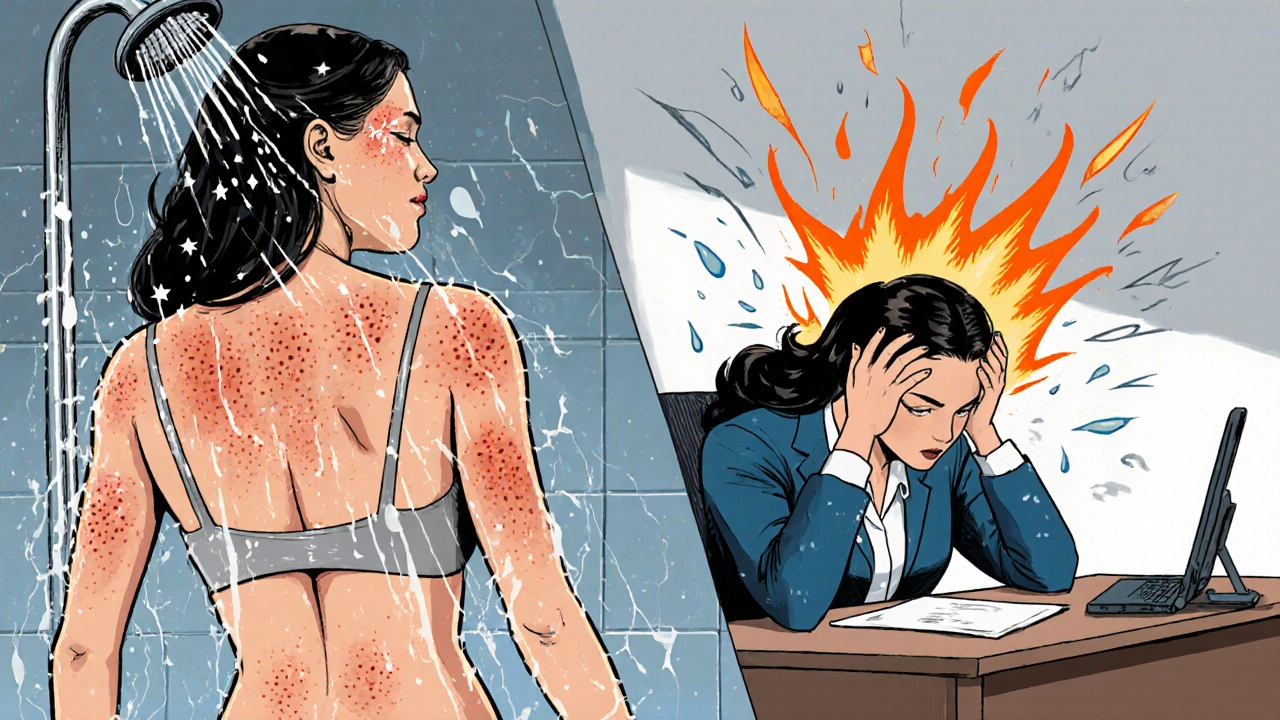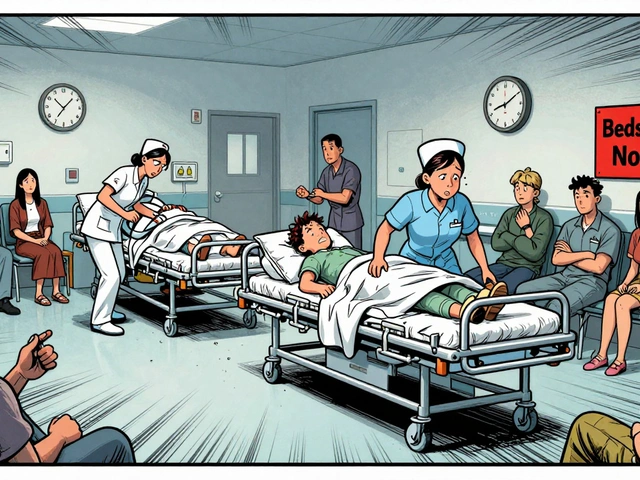
Imagine waking up with your skin covered in raised, red, itchy welts that seem to move around your body like a ghost. One minute they’re on your arm, the next they’re on your neck, then your legs. They burn, they itch, they keep you up at night. You’ve probably seen them on someone else-maybe a child after eating peanut butter, or a friend after a hot shower. These aren’t just a rash. They’re urticaria, commonly called hives.
Hives aren’t rare. About 1 in 5 people will get them at least once in their life. Women are more likely than men to experience them, especially between the ages of 20 and 50. What makes hives so confusing is that they can appear out of nowhere, last a few hours, or stick around for months. Some people get them after eating shellfish or taking ibuprofen. Others get them from stress, heat, sweat, or even pressure from tight clothes. And for many, no trigger is ever found.
What Exactly Are Hives?
Hives are not an infection. They’re not contagious. They’re not caused by poor hygiene. They’re the result of your body’s immune system overreacting. Inside your skin, there are cells called mast cells. When something triggers them-whether it’s a food, a drug, stress, or just unknown reasons-they release a chemical called histamine. Histamine makes tiny blood vessels leak fluid into the skin, causing those raised, red, itchy bumps you see.
Acute hives last less than six weeks. Chronic hives last longer than six weeks, sometimes for months or even years. About 70-80% of chronic cases have no clear trigger. This is called chronic spontaneous urticaria. It’s not allergies in the traditional sense. It’s more like your immune system is on high alert for no good reason.
Common Triggers-And the Ones You Won’t Expect
Some triggers are obvious. Shellfish, peanuts, eggs, dairy, and certain antibiotics like penicillin can cause hives in people with true allergies. But many people assume hives are always allergic-and they’re wrong.
Physical triggers are surprisingly common. Cold temperatures can cause hives in some people. Heat, sweat, sunlight, and even pressure from a backpack or waistband can trigger them. This is called physical urticaria. It accounts for 20-30% of chronic cases. If you break out after a hot shower, after exercising, or after wearing a tight bra, you might have one of these types.
Stress is another major one. Not because stress causes histamine release directly, but because it lowers your body’s ability to regulate inflammation. Many people notice their hives flare during work deadlines, family conflicts, or sleepless nights.
And then there’s the big mystery: chronic spontaneous urticaria. For most people with this condition, no trigger is ever found. Blood tests often come back normal. Allergy tests are negative. That doesn’t mean it’s “all in your head.” It means the immune system is misfiring in a way we don’t fully understand yet. About 30-40% of these cases may be linked to autoimmune activity, where your body accidentally attacks its own skin cells.
Antihistamines: The First Line of Defense
If you have hives, your doctor will almost always start you on an antihistamine. Why? Because they block histamine from binding to receptors in your skin. Less histamine binding = less itching, less swelling, fewer hives.
There are two types: first-generation and second-generation.
First-generation antihistamines-like diphenhydramine (Benadryl)-work fast. But they make you sleepy. About 50-70% of people feel drowsy after taking them. That’s fine for nighttime use, but terrible if you drive, work, or have kids to care for.
Second-generation antihistamines-like cetirizine (Zyrtec), loratadine (Claritin), and fexofenadine (Allegra)-are non-sedating for most people. They’re the go-to for daily use. Standard dose? Usually 10mg once a day for adults.
Here’s the catch: many people don’t take enough. For chronic hives, the guidelines say you can increase the dose up to four times the normal amount. So instead of 10mg, you take 40mg. That’s not dangerous. Studies show up to 50% of people who don’t respond to standard doses get relief with higher ones. Yet most patients never get told this.
One patient in Sydney told me: “I took Zyrtec at 10mg for three months. Nothing. My doctor finally said, ‘Try 20mg.’ Within a week, the hives were gone. Why didn’t anyone tell me to go higher?”

What If Antihistamines Don’t Work?
Half of people with chronic hives don’t get full relief from antihistamines-even at high doses. That’s when things get more complex.
For those cases, doctors turn to biologics. Omalizumab (Xolair) is the most common. It’s an injection given every four weeks. It works by targeting the antibody IgE, which plays a role in triggering mast cells. In clinical trials, it helped 65% of patients who didn’t respond to antihistamines. But it’s expensive-around $1,500 per shot in the U.S. Not everyone can afford it.
In September 2023, the FDA approved another biologic: dupilumab (Dupixent). Originally for eczema and asthma, it showed 55% of chronic hives patients had complete symptom relief in trials-compared to just 15% on placebo.
Then came remibrutinib, approved in January 2024. It’s the first oral drug in its class-a tyrosine kinase inhibitor. No injections. Just a pill, twice a day. In trials, 45% of patients had complete control of their hives. And 85% of people kept taking it, compared to 70% for injections. That’s a big deal. Adherence matters.
Other options like cyclosporine and prednisone exist, but they’re not ideal. Prednisone gives quick relief, but after just 3-5 days, side effects kick in: insomnia, mood swings, high blood sugar. Cyclosporine can damage kidneys over time. These are last-resort options.
Real People, Real Experiences
Online communities like Reddit’s r/ChronicHives have over 15,000 members. A survey of 1,245 people there showed:
- 68% said hives disrupted their sleep-often waking up 2-3 times a night.
- 42% said they missed work or social events because of flare-ups.
- 22% saw three or more doctors before getting the right diagnosis.
On drug review sites, second-generation antihistamines get decent ratings. Fexofenadine scores 4.1/5 for effectiveness, but only 3.2/5 for complete relief. That gap tells you something: they help, but they rarely fix everything.
Omalizumab users report 72% satisfaction. Many say, “Within four weeks, I was hive-free.” But 35% mention pain or swelling at the injection site. For some, the trade-off is worth it. For others, it’s too much.
One woman from Melbourne wrote: “I was on four antihistamines a day. Still broke out. I started Xolair. Week one: no change. Week two: fewer hives. Week three: none. I cried in the pharmacy. I hadn’t slept through the night in 18 months.”

How to Get Started
If you’re dealing with hives, here’s what to do:
- Start with a non-sedating antihistamine like cetirizine (10mg daily). Don’t wait. Don’t hope it’ll go away.
- Keep a symptom diary. Note what you ate, what you did, how stressed you felt, the weather, your sleep. Apps like Urticaria Tracker can help.
- If hives last more than two weeks, see an allergist or dermatologist. Don’t wait six weeks. Early intervention improves outcomes.
- If antihistamines aren’t working after a month, ask about up-dosing. Many doctors don’t know this is an option.
- If you’re still breaking out after 3-6 months on high-dose antihistamines, ask about biologics. You’re not failing. The treatment just needs to be stepped up.
Don’t assume hives are just “a minor allergy.” Chronic hives can wreck your sleep, your mood, your job, your relationships. They’re not just skin-deep. They’re a systemic immune issue.
What’s Next for Urticaria Treatment?
The field is moving fast. New drugs are coming. Linzagolix, expected for FDA approval by late 2024, showed 52% complete response in early trials. Researchers are also exploring genetic testing to predict who will respond to which antihistamine. One day, you might get a simple blood test that tells you whether cetirizine or fexofenadine will work better for you.
Telemedicine is helping too. In Australia, 45% of allergists now use video visits for hives follow-ups. That’s huge for people in rural areas who can’t travel to big cities.
But there’s still a gap. In low-income countries, only 30% of people with chronic hives can access biologics. In high-income countries, it’s 85%. That’s not fair. And it’s not just about money-it’s about awareness. Many doctors still treat hives like a simple allergy, not a chronic immune condition.
Final Thoughts
Hives are more than a rash. They’re a signal. A loud, itchy, sleep-stealing signal that something in your immune system is off. Antihistamines are the first tool, but not the only one. You don’t have to live with hives for years. There are effective treatments. You just need to know how to ask for them.
If you’ve been told, “It’s just hives, take an antihistamine,” and it didn’t work-you’re not crazy. You’re not alone. And there’s more help available than you think.
Are hives always caused by allergies?
No. While some hives are triggered by food or drug allergies, many are not. Physical triggers like heat, cold, pressure, or stress can cause them. In fact, 70-80% of chronic hives have no identifiable trigger at all. These are called chronic spontaneous urticaria and are linked to immune system dysfunction, not classic allergies.
Can I take more than one antihistamine at a time?
Yes, under medical supervision. Some people combine a non-sedating antihistamine during the day (like fexofenadine) with a sedating one at night (like hydroxyzine) to improve sleep and control symptoms. Studies show this combination can boost relief by up to 30%. But never combine them without talking to your doctor first.
How long should I try antihistamines before seeing a specialist?
If your hives last more than two weeks, it’s time to see a specialist. Don’t wait until they’ve been going for six weeks. Early diagnosis and treatment can prevent long-term complications. If you’ve been on a standard dose of antihistamine for a month with no improvement, ask about increasing the dose or moving to biologics.
Is omalizumab safe for long-term use?
Yes. Omalizumab has been used for over a decade in chronic hives and asthma. Long-term studies show it’s well tolerated. The main risks are injection site reactions and a very small chance of anaphylaxis (about 0.2%). Patients are usually monitored for 30 minutes after the first few doses. Most people use it safely for years with no serious side effects.
Can stress really cause hives?
Yes. Stress doesn’t directly cause histamine release, but it weakens your body’s ability to control inflammation. Many patients notice their hives flare during high-stress periods-job changes, family issues, or sleep loss. Managing stress through sleep, exercise, or therapy can reduce flare frequency, even if it doesn’t eliminate hives completely.
Do I need to avoid all potential triggers if I have chronic hives?
Not necessarily. For physical triggers like heat or pressure, avoiding them can help. But for chronic spontaneous urticaria, where no trigger is found, strict avoidance rarely helps. In fact, overly restrictive diets or lifestyle changes can increase anxiety and make hives worse. Focus on proven treatments first-antihistamines and biologics-then use trigger tracking only if you notice clear patterns.
Are there any natural remedies that work for hives?
Some people report relief from cold compresses, oatmeal baths, or supplements like quercetin or vitamin D. But there’s no strong scientific evidence that any natural remedy controls hives as effectively as antihistamines or biologics. Relying on unproven treatments can delay effective care. Always talk to your doctor before trying supplements, especially if you’re on other medications.
Can hives turn into something more serious?
Hives themselves are not dangerous. But if they’re accompanied by swelling of the lips, tongue, or throat (called angioedema), or difficulty breathing, that’s a medical emergency. That could be anaphylaxis. Also, if hives last more than six weeks, they may signal an underlying autoimmune condition. Always report new symptoms like joint pain, fatigue, or fever to your doctor.
14 Comments
Franck Emma
November 23, 2025 at 10:44 AM
This is why I hate doctors.
Noah Fitzsimmons
November 24, 2025 at 15:55 PM
Oh wow, so you're telling me the medical establishment has been lying to people for decades? That hives aren't allergies? Shocking. Next you'll say the moon landing was faked. At least Benadryl makes you sleep, unlike your ‘biologic’ nonsense that costs a mortgage payment. 😏
Eliza Oakes
November 25, 2025 at 10:15 AM
Okay but why does no one ever mention that antihistamines make you feel like a zombie? I took Claritin for six months. I couldn’t focus, my brain was foggy, and I still broke out. Then I tried a low-histamine diet. It didn’t fix everything, but I stopped crying every night. So yeah, maybe the real problem is we’re treating symptoms, not the root. Just saying.
Corra Hathaway
November 27, 2025 at 09:42 AM
Y’all are killing it with this thread!! 💪 I was on 4 antihistamines a day and still waking up covered in welts. Then I found out about the 4x dose thing. I was scared to ask my doc but I did… and now I’m hive-free for 3 months. You’re not broken. You just need the right dose. Also, oatmeal baths help a little. Not a cure, but they feel like a hug for your skin. 🧖♀️💖
Shawn Sakura
November 27, 2025 at 11:39 AM
Thank you for this article. I’ve had chronic hives for 14 years. My first doctor told me to ‘take an antihistamine and stop stressing.’ I cried in the parking lot. I finally saw a specialist after my third ER visit. They upped my dose. Then they tried Xolair. I’m not cured, but I’m living again. To anyone reading this: Don’t give up. You deserve to sleep. You deserve relief. 🙏
Donald Frantz
November 27, 2025 at 11:49 AM
Why is there no data on the long-term effects of doubling antihistamine doses? You mention studies but don’t cite them. Also, if 70-80% of chronic cases have no trigger, why are we still pushing trigger avoidance as a primary strategy? This feels like guesswork dressed as medicine. I want peer-reviewed sources, not anecdotes from Reddit.
Sammy Williams
November 29, 2025 at 02:02 AM
My wife got hives after a wedding. Thought it was stress. Turns out it was her new laundry detergent. We switched brands, boom - gone. But then she got them again a year later from nothing. We tried everything. Now she’s on Xolair. It’s expensive but worth it. I just want people to know: it’s not in your head. It’s real. And you’re not alone.
Nikhil Purohit
November 30, 2025 at 13:48 PM
I’m from India and we don’t have access to biologics here. My doctor gave me cetirizine and said ‘wait it out.’ I’ve had hives for 3 years. I can’t afford Xolair. I’ve tried Ayurveda, neem baths, turmeric - nothing works. I’m so glad you wrote this. At least now I know there’s more out there. Maybe one day it’ll be available here too.
Michael Marrale
December 1, 2025 at 02:44 AM
Wait… so you’re saying the government knows about this but hides it? Why do all these new drugs come out of Big Pharma? And why is the FDA approving them so fast? I bet they’re testing on people with hives to mask something bigger… like 5G or vaccines. I’ve seen the patterns. They don’t want you to know the truth. You’re being used.
David vaughan
December 2, 2025 at 04:10 AM
Just wanted to say: I tried the 4x dose. I was skeptical. I took 40mg of Zyrtec. Day 1: same. Day 2: a little better. Day 4: no new hives. Day 7: I slept through the night. I cried. I didn’t think it was possible. Thank you for sharing this. Seriously. Thank you.
David Cusack
December 2, 2025 at 21:59 PM
How quaint. You speak of antihistamines as if they’re the pinnacle of medical science. The real issue is the reductionist paradigm of immunology that still clings to the histamine model. Modern immunology has moved beyond this simplistic paradigm. The real breakthroughs lie in cytokine modulation and mast cell stabilizers - not over-the-counter antihistamines. Your article is charming, but fundamentally outdated.
Cooper Long
December 3, 2025 at 19:18 PM
Thank you for the comprehensive overview. This is precisely the kind of clear, evidence-based communication that is too often absent in public health discourse. The distinction between allergic and non-allergic urticaria is critical, and the emphasis on dose escalation and biologics is both accurate and urgently needed. Well done.
Sheldon Bazinga
December 5, 2025 at 04:25 AM
So you’re telling me I wasted 5 years on Benadryl because doctors are too lazy to read the guidelines? And now I gotta pay $1500 for a shot? I’m from Ohio. My insurance won’t cover it. So I’m just supposed to suffer because I’m poor? Great. Real great. This is why people don’t trust medicine. You guys are all just selling pills and fancy injections while the rest of us bleed out in silence.






Anne Nylander
November 21, 2025 at 13:15 PM
OMG I thought I was the only one who got hives after hot showers!! I used to think I was allergic to soap or something. Then my dermatologist said it was physical urticaria and told me to try Zyrtec at 20mg. I cried when they finally stopped. You’re not crazy, you’re just misunderstood. Keep going!! 🙌